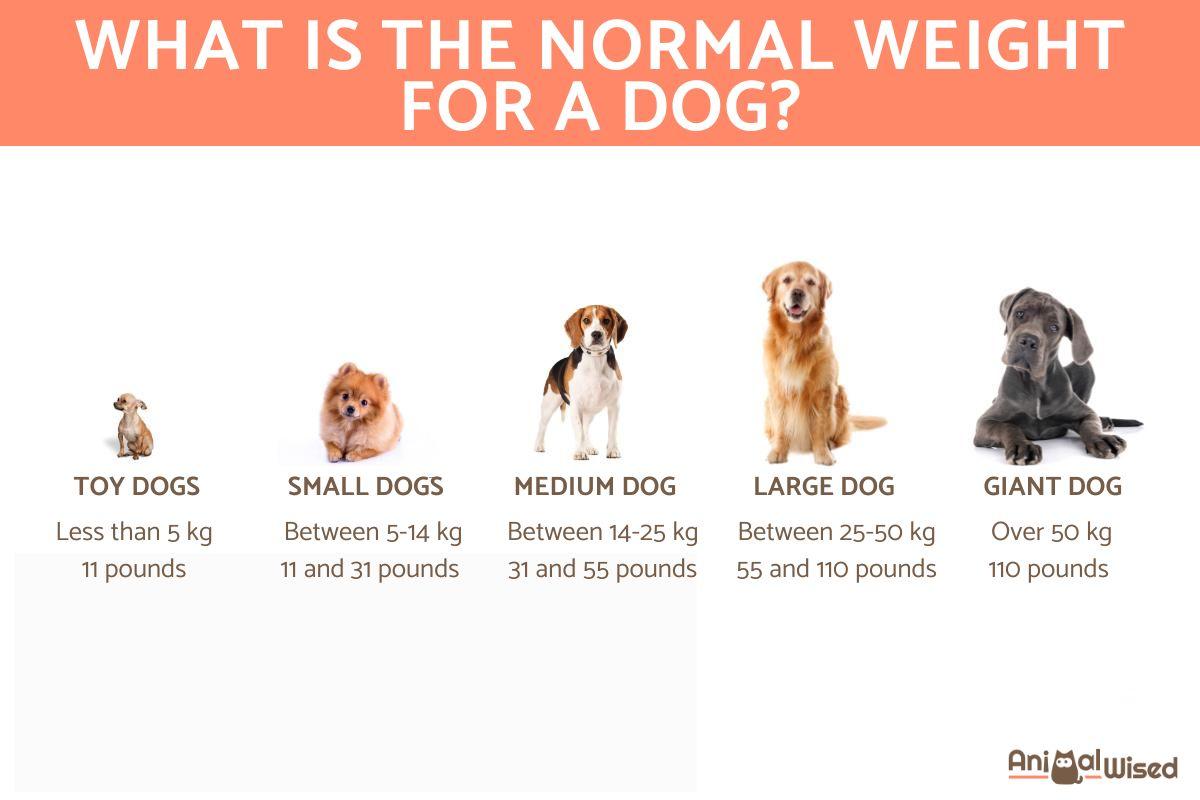What Is the Normal Weight for a Dog?



See files for Dogs
Determining the normal weight for your dog is crucial for their overall health and well-being. A dog who is either overweight or underweight can face various health issues, including joint problems, heart disease, and diabetes. While purebred dogs have established weight standards, mixed-breed dogs can vary widely. Understanding your dog's expected weight range can help you provide the best care possible.
In this AnimalWised article, we'll discuss what the normal weight for a dog is, the factors that influence a dog's weight and provide a guide on how to assess your dog's body condition.
What is a dog's ideal weight?
Ideal weight for a dog refers to the weight range that is considered healthiest and most beneficial for that particular breed and individual dog. It's based on factors like:
- Breed: different breeds have different body types and size standards.
- Age: puppies and senior dogs may have different weight requirements.
- Health: underlying health conditions can influence ideal weight.
- Activity level: more active dogs may need more calories.
Being either overweight or underweight can lead to health issues such as joint problems, heart disease, and diabetes. Keeping your dog at a healthy weight can contribute to a longer, more comfortable life. A dog at an ideal weight is typically more energetic and better able to enjoy daily activities.

How to determine your dog’s ideal weight?
For purebred dogs, there are specific weight standards that define the ideal weight range. However, for crossbreed dogs, there’s a vast range of potential sizes and weights, making it challenging to provide a one-size-fits-all figure. For instance, consider the vast difference in size between a Chihuahua and a Great Dane.
When exact weight guidelines aren't available, checking your dog’s body condition is important to see if it's at a healthy weight. To do this, focus on three main areas: the ribs, waist, and belly.
- Ribs: the ribs should not be visible but should be easily felt when you run your hand over them.
- Waist: there should be a slight indentation at the waist, and the belly should be tucked in.
- Belly: dogs that are underweight will have visible ribs, a pronounced waist, and a deeply tucked belly. Conversely, dogs that are overweight or obese may have a less defined waist, a hanging belly, or ribs that are difficult to feel.
If you're looking to manage your dog’s weight, explore how homemade meals can make a difference in our next article.

How much do small dogs weigh?
The weight of small dogs can vary significantly depending on their breed. Some of the smallest dog breeds, like the Chihuahua or the Yorkshire Terrier, may weigh as little as 1.8-2.7 kg (4-6 pounds). Larger small breeds, like the French Bulldog or the Boston Terrier, may weigh around 6.8-11.3 kg (15-25 pounds).
While "small dog" often refers to dogs weighing less than 5 kg (11 lbs), a broader definition includes dogs up to 10 kg (22 lbs) as small. Dogs under 5 kg are usually called toy dogs, but some small breeds might weigh more due to their sturdy build, so size alone isn’t the only factor.
Many people look for very small dogs thinking they’re easier to manage, but predicting a puppy’s final weight can be tricky, especially if the parents are unknown. Leg size is not a reliable indicator of final weight. Instead, using a weight chart for small dogs can be more helpful. As a general guide:
- At 2 months: about 2.5-3.5 kg (5.5-7.7 lbs)
- At 4 months: around 4.5-6 kg (9.9-13.2 lbs), usually reaching half of their adult weight
Small dogs, regardless of their final adult weight, tend to reach maturity faster than larger breeds, so they grow rapidly in their early months.
Remember that weight estimates for 3-month-old, 6-month-old, or 9-month-old dogs can vary widely due to different sizes and builds.
Here are a few examples of small dog breeds and their approximate weight ranges:
- Chihuahua: 0.9-2.7 kg (2-6 pounds)
- Yorkshire Terrier: 1.8-3.2 kg (4-7 pounds)
- Pomeranian: 1.4-3.2 kg (3-7 pounds)
- French Bulldog: 7.3-12.7 kg (16-28 pounds)
- Boston Terrier: 6.8-11.3 kg (15-25 pounds)
It's important to note that these are just approximate ranges and individual dogs may weigh slightly more or less. If you're unsure about your small dog's ideal weight, it's always best to consult with your veterinarian. If your dog’s appetite seems out of control, there could be underlying factors at play. Check out our article for insights into managing excessive hunger.

How much do medium-sized dogs weigh?
Medium-sized dogs usually weigh between 10 and 25 kg (22 to 55 lbs). If you have a puppy of unknown parentage and want to estimate its adult weight, it’s more reliable to use a weight chart for medium-sized dogs rather than relying on physical traits like leg size. These charts provide general guidance.
For example, average weights for medium-sized dogs are approximately:
- At 2 months: around 2.3-4 kg (5-8.8 lbs)
- At 4 months: about 5.8-9.5 kg (12.8-21 lbs)
In addition to tracking weight, evaluating your dog’s body condition is crucial to determine if it is at a healthy weight, underweight, or overweight. This assessment helps in adjusting the amount of food given to meet the dog’s needs.
Here are a few examples of medium-sized dog breeds and their approximate weight ranges:
- Beagle: 9.1-13.6 kg (20-30 pounds)
- Dachshund: 7.3-14.5 kg (16-32 pounds)
- Bulldog: 18.1-22.7 kg (40-50 pounds)
- Golden Retriever: 25-34 kg (55-75 pounds)
- Labrador Retriever: 25-36 kg (55-80 pounds)
As with small dogs, individual dogs within a breed may weigh slightly more or less than the average. If you're unsure about your medium-sized dog's ideal weight, it's always best to consult with your veterinarian.
Wondering how to help an underweight dog? Check out our guide on healthy ways to boost your dog’s weight naturally.

How much does a large dog weigh?
Large dogs are those that weigh over 25 kg (55 pounds) as adults, with some large breeds reaching up to 50 kg (110 pounds) or more.
A common misconception is that large dogs require massive amounts of food and extra supplements like calcium. While large dogs do eat more than smaller breeds, they don’t need excessive portions or unnecessary supplements beyond their dietary requirements. Overfeeding and improper supplementation can lead to growth problems, so it's crucial to follow feeding recommendations and monitor their body condition.
To estimate the weight of a large breed puppy at different stages, a weight chart for large dogs can offer general guidance. For example:
- At 2 months: approximately 8-9 kg (18-20 pounds)
- At 4 months: around 16-18 kg (35-40 pounds)
Large dogs take longer to reach their full size. Unlike smaller breeds, which may reach half their adult weight by 4 months, large breeds typically keep growing until they’re 18 to 24 months old.
Here are a few examples of large dog breeds and their approximate weight ranges:
- German Shepherd: 29.5-38.6 kg (65-85 pounds)
- Doberman Pinscher: 27.2-36.3 kg (60-80 pounds)
- Great Dane: 59-77 kg (130-170 pounds)
- Mastiff: 72.6-104.3 kg (160-230 pounds)
- Newfoundland: 59-68 kg (130-150 pounds)
Noticing your dog shedding pounds too quickly? We dive into the possible reasons and what you can do next in our related article.

How much does a giant dog weigh?
Giant or very large dogs typically weigh over 50 kg (110 pounds) and can reach up to 100 kg (220 pounds), making them the largest breed category. Here are a few examples of giant dog breeds and their approximate weight ranges:
- Great Dane: 59-77 kg (130-170 pounds)
- Mastiff: 72.6-104.3 kg (160-230 pounds)
- St. Bernard: 63.5-81.6 kg (140-180 pounds)
- Newfoundland: 59-68 kg (130-150 pounds)
- Irish Wolfhound: 54.4-81.6 kg (120-180 pounds)
While the general categories of small, medium, large, and giant dogs provide a helpful framework, it's important to remember that these are just broad classifications. There can be significant variations in size within each category
A giant dog's weight can vary due to factors like age, sex, and overall health. For the most accurate assessment of your dog's ideal weight and well-being, it’s important to consult a veterinarian. If your dog is eating but not gaining weight, there's more to the story. Discover what might be happening in our related article.

If you want to read similar articles to What Is the Normal Weight for a Dog?, we recommend you visit our Basic care category.
- Carlson and Giffin (2022): Practical manual of canine veterinary medicine . Madrid: Editorial el Drac.
- Waltham Center (2022): growth curves, published by Royal Canin, available at https://vetacademy.royalcanin.es/wp-content/uploads/2022/05/Curva-crecimiento_Cachorro.pdf











